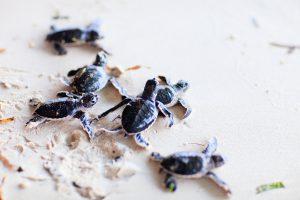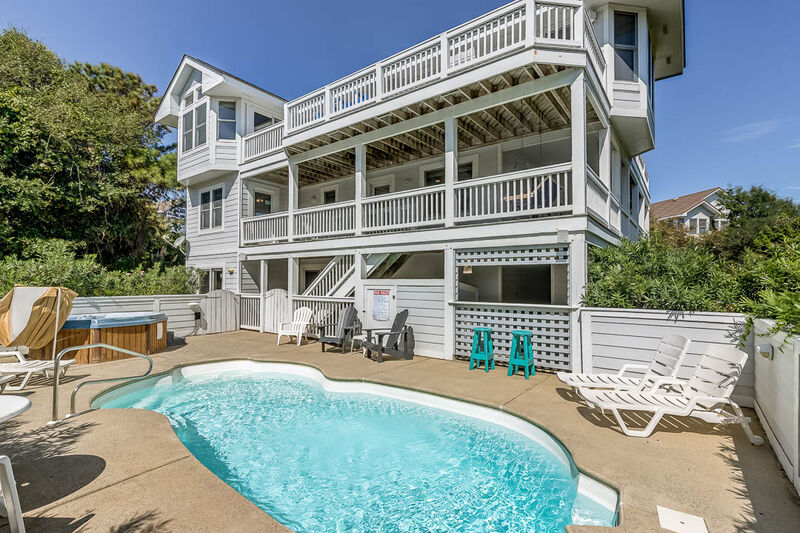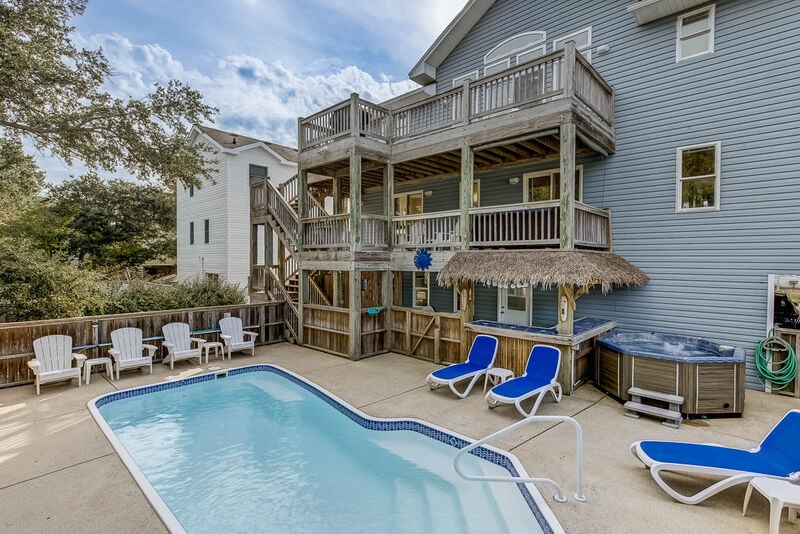
Visit the Outer Banks between May and September and you may get to witness one of Nature's most amazing sights: nesting sea turtles. Did you know that sea turtles spend their lives in deep water, only coming ashore to lay eggs? Sea turtles are among the largest reptiles on Earth — some can reach almost 2,000 pounds. It can take up to 50 years for a female sea turtle to be ready to reproduce, and then she can live to be 100. Little is known about these mysterious creatures, which is one of the reasons that locals are passionate about protecting them.
Types of Turtles
Five different types of sea turtle come ashore to lay eggs on Outer Banks beaches: The rare Hawksbill, Kemp's Ridley, loggerhead, green, and the largest species, leatherback turtles. Leatherback turtles are truly a sight to behold. As the largest of all turtles and the largest reptile besides crocodiles and alligators, leatherbacks can grow up to five feet long and have flippers that can reach up to nine feet long.
Nesting Cycle
In late spring, female sea turtles migrate hundreds of miles from their foraging grounds to their nesting beaches. Sea turtles primarily make their nests and lay their eggs at night. Nests contain about 100 eggs (called a "clutch"), and take about 60 days until they're ready to hatch. Interestingly, the temperature of the sand determines the sex of most of the hatchlings; warmer sand produces more females while cooler sand produces more males. The cooler sand of the Outer Banks tends to produce mostly male turtles while the warmer sands in Florida produce mainly female.After the mother lays her eggs, she slowly makes her way back to the sea and swims off into the sunrise. Nests are left unprotected, which means they are particularly vulnerable to predators (including dogs), weather, and human activity. When they hatch, baby sea turtles use light as a visual cue for moving toward the sea. Once they hit the waves, they'll swim for the next two to three days toward the Gulf Stream. The warm waters of the Gulf Stream are abundant in seaweed, which provides a safe place for growing sea turtles to mature for the first 10 years of life. However, the trip out of the nest to the Gulf Stream is perilous — estimates are that only one in thousands of hatchlings will survive to adulthood.
Where They Nest
Sea turtles nest in the dunes all along the Outer Banks. Cape Hatteras is particularly active, but nests can be found from Corolla to Oregon Inlet. To protect nests, volunteers comb the beaches at dawn every morning and mark nests with stakes and tape. Watch for nests along the dunes and report an unmarked nest to the Network for Endangered Sea Turtles (N.E.S.T.) hotline at (252) 441-8622.
Turtle Dos and Don'ts
Turtle eggs and hatchlings are incredibly fragile, and the odds are stacked against them. If you're visiting the Outer Banks, it's important that you watch out for our favorite little visitors by following these rules:
- Stay away from marked turtle nests, keep dogs on a leash, and be sure kids know to leave nests alone.
- Fill in holes before you leave the beach, and fill in holes you see as you're walking the beach. Baby sea turtles can easily fall in a hole on their way to the ocean, and they have no way to get out.
- Don't shine lights at a nest or take flash photographs of a turtle or a nest.
- Turn off exterior house lights if you're renting a house on the beach. Turtles can mistake porch lights for the moon and go the wrong way.
- Pick up litter on the beach. Turtles can become entangled in the smallest toys and trash.
- If you see a turtle on the beach that is not nesting, she is likely sick. Call N.E.S.T. right away so she can be moved to a rehab facility.
Learn More About Turtles
N.E.S.T has educational and volunteer opportunities for those who want to learn more about sea turtles. You can volunteer to nest-sit or comb beaches on your vacation, or take part in local fundraising activities on the islands.Sick and injured sea turtles heal up at the Sea Turtle Assistance and Rehabilitation Center at the Aquarium on Roanoke Island. You can learn more about these incredible creatures at the STAR Center and interactive Sea Turtle Rescue exhibit.Wander the Outer Banks from May through September and you may be privy to one of the most wondrous spectacles on the barrier islands. Sea turtles are an important part of our environment and culture, so remember the turtle safety rules when you're at the beach. If you're up late, keep your eyes peeled for the Outer Banks' rarest and most respected visitors.
 Visit the Outer Banks between May and September and you may get to witness one of Nature's most amazing sights: nesting sea turtles. Did you know that sea turtles spend their lives in deep water, only coming ashore to lay eggs? Sea turtles are among the largest reptiles on Earth — some can reach almost 2,000 pounds. It can take up to 50 years for a female sea turtle to be ready to reproduce, and then she can live to be 100. Little is known about these mysterious creatures, which is one of the reasons that locals are passionate about protecting them.
Visit the Outer Banks between May and September and you may get to witness one of Nature's most amazing sights: nesting sea turtles. Did you know that sea turtles spend their lives in deep water, only coming ashore to lay eggs? Sea turtles are among the largest reptiles on Earth — some can reach almost 2,000 pounds. It can take up to 50 years for a female sea turtle to be ready to reproduce, and then she can live to be 100. Little is known about these mysterious creatures, which is one of the reasons that locals are passionate about protecting them.





